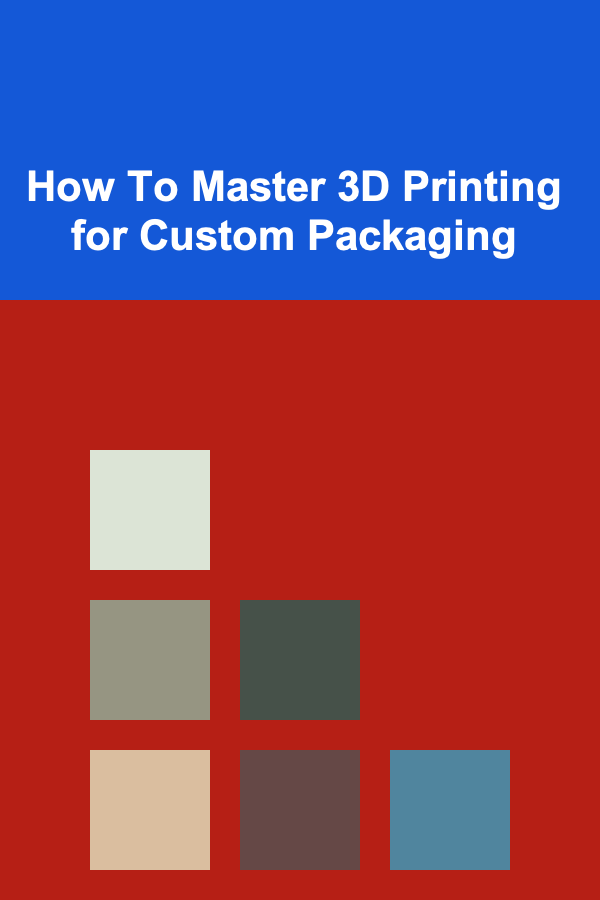
How To Master 3D Printing for Custom Packaging
ebook include PDF & Audio bundle (Micro Guide)
$12.99$10.99
Limited Time Offer! Order within the next:

3D printing has revolutionized many industries, from manufacturing to healthcare, and its application in packaging is no exception. Custom packaging, which allows for personalized designs, shapes, and sizes, can now be produced with unprecedented flexibility and efficiency through 3D printing technologies. For businesses seeking to stay ahead of the curve, mastering 3D printing for custom packaging is not just a luxury but a necessity.
In this article, we will delve deep into the nuances of 3D printing for custom packaging, exploring its advantages, the process of mastering this technology, potential challenges, and how to overcome them. Whether you're a designer, an entrepreneur, or part of a packaging company, this guide will equip you with the knowledge to excel in the future of packaging.
Understanding the Fundamentals of 3D Printing in Packaging
Before delving into the specifics of mastering 3D printing for custom packaging, it's essential to understand the technology itself.
What Is 3D Printing?
3D printing, or additive manufacturing, is a process of creating three-dimensional objects from a digital file. In this process, material is added layer by layer until the desired object is formed. The materials used in 3D printing vary widely, from plastics and resins to metals and ceramics, making it a versatile technology.
For custom packaging, 3D printing typically involves the creation of prototypes, molds, or even the final product, offering a level of design freedom that traditional manufacturing methods cannot match.
How Does 3D Printing Work in Packaging?
In the context of packaging, 3D printing is used to create custom-designed packages that are tailored to the exact needs of a product. This could involve unique shapes, intricate details, and specific size constraints. Here's a simplified breakdown of the 3D printing process for packaging:
- Design Phase: The first step in the process is creating a 3D design of the packaging. This can be done using Computer-Aided Design (CAD) software. The design must be precise to ensure that the packaging fits the product correctly and functions as intended.
- Prototyping: Once the design is complete, a prototype is created using a 3D printer. This prototype allows the designer to test the packaging for functionality, fit, and aesthetics. Adjustments can be made before moving to production.
- Final Printing: Once the prototype is approved, the final version of the custom packaging can be printed. Depending on the material and printer type, the packaging may be produced in a single or several parts that are then assembled.
- Post-Processing: After printing, the packaging may undergo post-processing steps such as cleaning, painting, or applying finishes to enhance the final look and feel.
Types of 3D Printing Technologies for Custom Packaging
Several types of 3D printing technologies can be employed in custom packaging. The choice of technology depends on the material used, the complexity of the design, and the specific needs of the packaging. Common 3D printing methods used in packaging include:
- Fused Deposition Modeling (FDM): This is one of the most common types of 3D printing. FDM uses thermoplastic materials, such as PLA and ABS, which are extruded layer by layer. This method is ideal for creating durable and functional packaging prototypes.
- Stereolithography (SLA): SLA uses light to cure resin material layer by layer. This technology is capable of producing highly detailed prints with smooth surfaces, making it suitable for creating intricate packaging designs.
- Selective Laser Sintering (SLS): SLS uses a laser to fuse powdered material into a solid shape. It is ideal for creating complex geometries and is particularly useful when strength and durability are required for packaging components.
- Digital Light Processing (DLP): DLP is similar to SLA but uses a digital light projector to cure the resin. It's faster than SLA and is often used for packaging prototypes with high detail and precision.
- Multi Jet Fusion (MJF): MJF involves spraying a binding agent onto a powdered material and then applying heat to fuse the layers. This technique is often used for creating functional packaging parts with strong mechanical properties.
Each technology has its advantages and limitations, so selecting the right one for your custom packaging project is essential.
Advantages of 3D Printing for Custom Packaging
There are numerous reasons why businesses are increasingly turning to 3D printing for their packaging needs. Here are some of the key benefits:
1. Design Flexibility
3D printing allows for a level of design freedom that traditional manufacturing methods simply cannot offer. Designers can create complex, intricate shapes and structures that would be impossible or prohibitively expensive to produce using molds or injection molding. This flexibility enables companies to develop highly personalized packaging that reflects their brand's identity and stands out in the marketplace.
2. Rapid Prototyping
Traditional packaging design and prototyping can take weeks, if not months, to finalize. With 3D printing, prototypes can be created in a matter of hours or days, allowing for faster iterations and design improvements. This speed can significantly reduce the time it takes to bring a product to market.
3. Cost-Efficiency for Small Runs
For small batches or limited-edition products, traditional manufacturing methods like injection molding can be prohibitively expensive due to the cost of creating molds. With 3D printing, there are no mold costs, and you can print custom packaging in low quantities without incurring high costs. This makes it a perfect solution for small businesses, startups, and niche markets.
4. Customization
3D printing enables businesses to produce highly customized packaging. Whether it's a unique shape, a personalized message, or a design that incorporates your company's branding, 3D printing makes it possible to create one-of-a-kind packaging that resonates with consumers.
5. Sustainability
Many 3D printing materials are more sustainable than traditional packaging materials. For example, some 3D-printed packaging can be made from biodegradable or recyclable materials, helping businesses reduce their environmental footprint. Additionally, the precision of 3D printing reduces material waste, making it an eco-friendly option for packaging production.
Mastering 3D Printing for Custom Packaging: A Step-by-Step Guide
Now that we have a solid understanding of 3D printing for custom packaging, it's time to focus on how to master the process. Mastery in this area requires a combination of knowledge, skills, and experience. Here is a step-by-step guide to help you become proficient in 3D printing for packaging.
Step 1: Learn the Basics of 3D Design
Mastering custom packaging begins with learning how to design in 3D. CAD software is at the heart of this process. Programs like AutoCAD, SolidWorks, and Rhino are commonly used in the packaging industry. If you are new to 3D design, start with tutorials and online courses to familiarize yourself with these tools.
When designing packaging, it's important to consider not just aesthetics but also functionality. Your packaging should be designed to protect the product, be easy to handle, and be cost-effective to produce. Learning about material properties, structural integrity, and manufacturing limitations is key to creating designs that work in the real world.
Step 2: Select the Right Materials
Choosing the right material is crucial to the success of your 3D printed packaging. The material must be strong enough to protect the product while also meeting any environmental or aesthetic requirements. Common materials used in 3D printed packaging include:
- PLA (Polylactic Acid): A biodegradable plastic that is often used for prototypes or products that will not be exposed to harsh conditions.
- ABS (Acrylonitrile Butadiene Styrene): A strong, durable plastic commonly used for functional packaging.
- Nylon: A versatile material with excellent strength and durability, ideal for packaging that needs to withstand wear and tear.
- PETG (Polyethylene Terephthalate Glycol): A recyclable material known for its strength, impact resistance, and clarity, making it suitable for consumer packaging.
Different materials offer different benefits, so selecting the right one for your packaging is essential.
Step 3: Perfect Your 3D Printing Skills
After mastering design and material selection, it's time to practice 3D printing itself. Start with a desktop 3D printer if you're just beginning, or consider outsourcing to a 3D printing service for larger runs. Experiment with different print settings, such as layer height, infill density, and print speed, to achieve the best results.
Pay attention to post-processing steps as well. Even though 3D printing can create highly detailed designs, finishing processes like sanding, painting, or sealing may be necessary to ensure the packaging looks polished and professional.
Step 4: Create Prototypes and Test
Once you've designed and printed your custom packaging, it's time to test it. Does it protect the product as expected? Is it easy to handle and open? Are the aesthetics appealing to consumers? Prototyping allows you to identify and resolve any issues before moving to full-scale production.
Consider conducting focus groups or getting feedback from potential customers to ensure the packaging design resonates with your target audience. Iterating on your prototype is a crucial part of the design process.
Step 5: Scale Up Production
After perfecting your design and prototype, it's time to scale up production. If you're producing small runs, you can continue printing the packaging in-house. However, for larger quantities, you may need to outsource production to a 3D printing service that can handle the required volume.
Keep in mind that 3D printing for custom packaging, while cost-effective for small runs, may not be the most economical option for mass production due to the slower production speeds compared to traditional methods. For larger quantities, you might consider combining 3D printing for prototyping and design testing, followed by traditional manufacturing for mass production.
Overcoming Challenges in 3D Printing Custom Packaging
While 3D printing for custom packaging offers many advantages, there are also challenges that businesses need to navigate. Here are some common hurdles and how to overcome them:
1. Cost of 3D Printing Equipment
Investing in a 3D printer can be expensive, especially for high-end models capable of producing quality packaging. To overcome this, businesses can start with entry-level printers for prototyping and small runs or outsource printing to third-party services.
2. Material Limitations
Although 3D printing offers a wide range of materials, not all of them are suitable for all packaging applications. Ensure that you select the right material for your product and that it meets the required strength, durability, and aesthetic standards.
3. Time Constraints
3D printing can be slower than traditional manufacturing methods, especially for large runs. To speed up the process, experiment with optimizing print settings, or combine 3D printing for prototyping and traditional manufacturing for large-scale production.
Conclusion
Mastering 3D printing for custom packaging is an exciting opportunity for businesses to create unique, functional, and cost-effective packaging solutions. With the right design skills, material selection, and printing expertise, companies can produce custom packaging that enhances their product's appeal, reduces waste, and accelerates time-to-market. As technology continues to evolve, the potential for 3D printing in packaging will only expand, offering even more possibilities for innovation and creativity.
Reading More From Our Other Websites
- [Gardening 101] The Benefits of a Butterfly Garden: Why You Should Start One
- [Personal Finance Management 101] How to Create a Debt-Free Lifestyle and Stick to It
- [Skydiving Tip 101] How to Overcome Fear of Opening the Canopy Through Progressive Visualization
- [Personal Care Tips 101] How to Achieve Perfect Cuticles with a Regular Cuticle Oil Routine
- [Home Storage Solution 101] How to Maximize Closet Space with Simple Organization Hacks
- [Organization Tip 101] How to Use Labels for Easy Identification of Plants
- [Home Party Planning 101] How to Plan a Party for Introverts: What Are the Best Tips for a Comfortable Experience?
- [Personal Investment 101] The Top Ways to Generate Passive Income Using Deep Learning
- [Organization Tip 101] How to Set Up a Family-Friendly Bathroom Organization System
- [Organization Tip 101] How to Fix Cracks and Damage Before Sealing Your Driveway

How to Make the Most of Your Employee Benefits
Read More
How to Use Lighting to Create a Mood in Your Living Room
Read More
Top Tips for Saving on Taxes and Maximizing Your Refund
Read More
How to Date When You're Unsure What You Want
Read More
How To Combat Acne Breakouts Effectively
Read More
Delicious & Healthy Dips: A Comprehensive Guide
Read MoreOther Products

How to Make the Most of Your Employee Benefits
Read More
How to Use Lighting to Create a Mood in Your Living Room
Read More
Top Tips for Saving on Taxes and Maximizing Your Refund
Read More
How to Date When You're Unsure What You Want
Read More
How To Combat Acne Breakouts Effectively
Read More